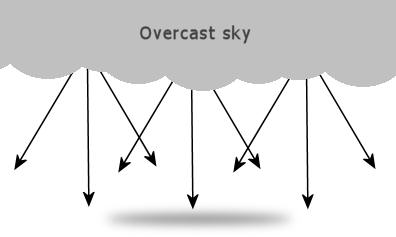One thing you can count on during the Spring and Summer months in southern California is the marine layer: a cool, foggy layer of air blown ashore each evening that doesn’t burn off until around noon. Every morning starts out cool and overcast. Overcast conditions aren’t typically what photographers talk about when they discuss beautiful light. The “golden hour” (dawn and dusk) is only golden if you can see the sun. But overcast conditions have their advantages as well and you can still take great photographs under a gray sky as long as you choose your subjects carefully.
Direct sunlight is extremely harsh. Many photographers don’t even bother shooting under midday sunlight. The slanting rays at dawn and dusk are softer, warmer, and don’t create the deep shadows you see at noon. In contrast, when the sky is overcast, the sun isn’t shining directly at all. All of the light has been filtered and softened by the cloud layer above. It’s sort of like a gigantic, gray soft box for the sun. Because the light isn’t as directional, shadows are much softer or non-existent and the overall lighting is very even. It makes exposure metering very easy because you don’t have to worry about contrast and dynamic range issues.

An overcast sky creates diffuse lighting that bounces and reflects
off of everything in the scene creating even lighting and soft shadows.
At the same time though, the light from an overcast sky is cold. It has none of the brightness of direct sunlight and none of the warmth of dawn or dusk light. Everything takes on a grayish cast because it is reflecting the gray sky above. Overcast days are not typically useful for grand landscape photographs. Shooting water can also be problematic because it will reflect so much of the gray sky above. Colors in general will be somewhat muted. And forget about shooting the gray, featureless expanse of the sky itself (unless you’ve got a stormy overcast sky with dramatic patches of dark and ominous clouds).
Overcast days are the time to focus on smaller scenes. Closeups of flowers, leaves, rocks, and colorful patterns. Portraits can work well under these conditions because of the subdued lighting and soft shadows. If you can, compose your scene to include as little of the sky as possible since it will only turn out as a dull, gray background. Concentrate on details rather than grandiose scenes and you’ll be able to make the most of those dull lighting days.









Awesome article on lighting! If you could compile some kind of “book” about lighting situations and other things relating to photography, I would print that out.. It’d be nice to have a little hand book to reach into my camera bag when I’m unsure! 🙂
When you look for an article on shooting in overcast conditions, the advice to avoid shooting the sky is a little useless.
Thanks for the effort but I was hoping for more tips and tricks with exposure, composition, maybe fill flash etc.